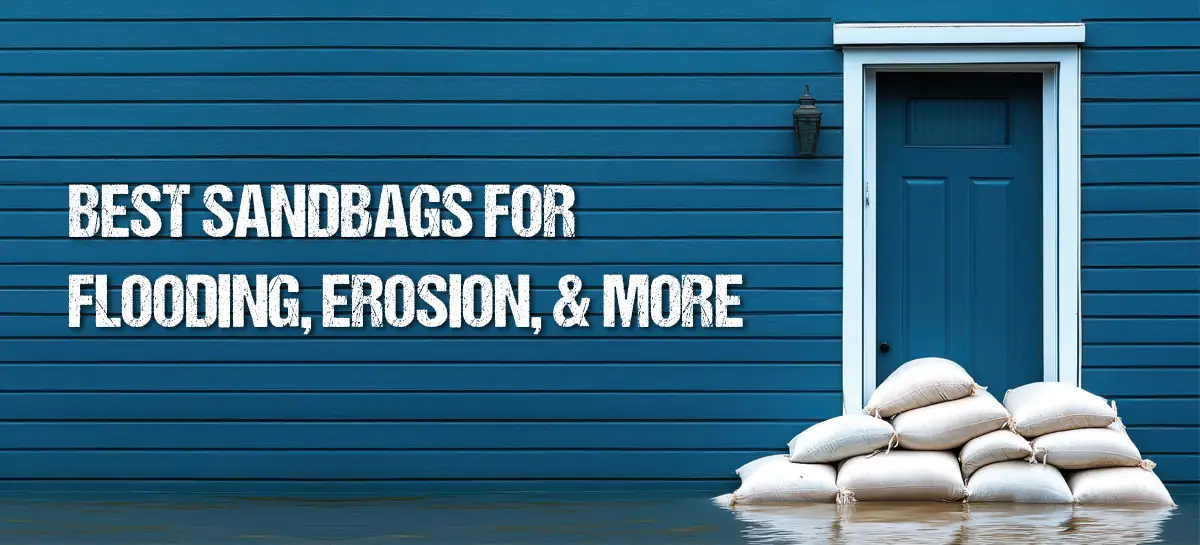Best Sand For Sandbags For Flooding, Erosion, Fortifications & More

Choosing the best sand for sandbags can make the difference between a strong, reliable barrier and one that collapses when you need it most. Too coarse, and it leaks. Too fine, and it shifts. The wrong fill can compromise your flood defense, erosion control, or emergency fortification.
To get it right, choose clean, dry, coarse-grain sand that compacts well and holds shape without clumping. It’s the ideal fill for long-lasting stability in high-pressure environments like flooding or construction zones.
Sand is of little use without sandbags! Browse our sand bags for sale to complete your setup
What is the best sand for sandbags?
The best sandbag filler depends on your specific use—whether it’s for flood control, erosion prevention, fortifications, or ballast. Using the right type of sand improves the barrier’s effectiveness, weight distribution, and structural integrity over time.
Below is a quick-reference table outlining the best sand types based on their performance in different applications:
| Application | Recommended Sand Type | Key Properties |
|---|---|---|
| Flood Protection | Washed Coarse Sand | Drains water well, resists compaction, reusable |
| Water Diversion | Fine Sand or Silt Mix | Forms tight seal, low permeability |
| Erosion Prevention | Washed Coarse Sand | Stable base, good weight, minimal washout |
| Fortifications | Dry Fill Sand | Packable, absorbs impact well |
| Hurdles | Dry Sand with Small Gravel | Heavy, stable, low movement under stress |
| Construction Support | Utility Sand | Dense, compacting, affordable |
| Allied Tanks (military/defense) | Clean Dry Sand | Consistent fill, no moisture-related weight gain |
| Weight Training and Fitness | Dry Playground Sand or Specialty Rubber Mix | Consistent weight, safe for handling, low dust |
| Protecting Underground Utilities | Cushion Sand | Fine, clean, prevents damage to pipes |
| Securing Tarps and Covers | Dry General Purpose Sand | Heavy enough to anchor, widely available |
| Landscaping Edging and Hardscaping Support | Compactable Sand or Masonry Sand | Good for stabilizing pavers, shaping edges, reusable bags |
Best sand for sandbags for flooding
When it comes to the best sand for flood sandbags it’s best to go with clean, coarse sand. Coarse sand has larger particles that compact tightly, helping to block floodwater and prevent seepage. This type of sand also drains well, reducing the chance of mold and weakening. The type of sand you use affects how well the bags stack, hold their structure, and protect your home and property during severe weather.
Water diversion
For redirecting water flow, such as around driveways or construction sites, the ideal type of sand you use is a medium to coarse variety. Coarse sand helps the bags hold their shape under pressure and allows just enough drainage to prevent buildup behind the barrier. It’s essential for flood barriers used in water diversion, as the sand ensures stability and helps the bags stay in place even during high flow.
Erosion prevention
In erosion control, the sand should be dense, uniform, and able to compact tightly. Washed river sand is ideal for this because it doesn’t shift easily and supports proper sandbagging. It offers a good balance of drainage and weight. Erosion control sandbags are often used along shorelines, slopes, and other vulnerable terrain.
Fortifications
For building fortifications, such as military-grade sandbags or structural barriers, angular, dry coarse sand works best. The particles lock together, adding weight and reducing movement. This type of sand provides strong support and is less likely to shift under pressure. It’s commonly used in UK-style sandbagging for long-term setups in disaster zones and construction.
Temporary use
If you’re in a DIY situation or facing a disaster emergency, general-purpose building sand or even beach sand can be used in a pinch. These are readily available and cost-effective, though they may not perform at their best under high water pressure or for long durations.
How many sandbags do I need? Well, keep in mind that general-purpose sand affects the weight of a sandbag, making them easier or harder to move, depending on grain size.
Best sand for workout sandbags
We get it—we’re not exactly a premier workout site, but we didn’t want you to leave without an answer. The best sand for weight bags used in training is typically dry play sand or a rubber/sand mix. The rubber adds flexibility and bounce, acting as the best sandbag filler alternative for fitness use. This mix is easier on the body, helps balance the load, and holds up well in training gear.
Uses of sandbags go far beyond just flood prevention—they’re used in military, construction, fitness, and agricultural settings.
Need sandbags for flooding or other uses? Get in touch today!
If you’re dealing with flooding, erosion, or any high-impact project, choosing the right sand is criticial—and so is having the right bags. Palmetto Industries offers a wide range of versatile, durable sandbags designed to contain, stabilize, and handle tough conditions.
We also help customers explore the different types of bags available and guide them on the sand used based on their purpose, cost, and availability. We’ll help you understand how different types of sand, how much does a sandbag weigh, and how you fill each bag—usually halfway to three-quarters full—affect its weight, drainage, and performance.
If you’re ever exploring alternatives to sandbags for flooding, remember: nothing beats the real thing when it’s filled with the right sand for the right job.
Contact us today to learn more, request a quote, or determine which option will work most effectively for your needs. We’re here as a reliable sand bag manufacturer to help you properly prepare, making it easier to act when it matters most.





